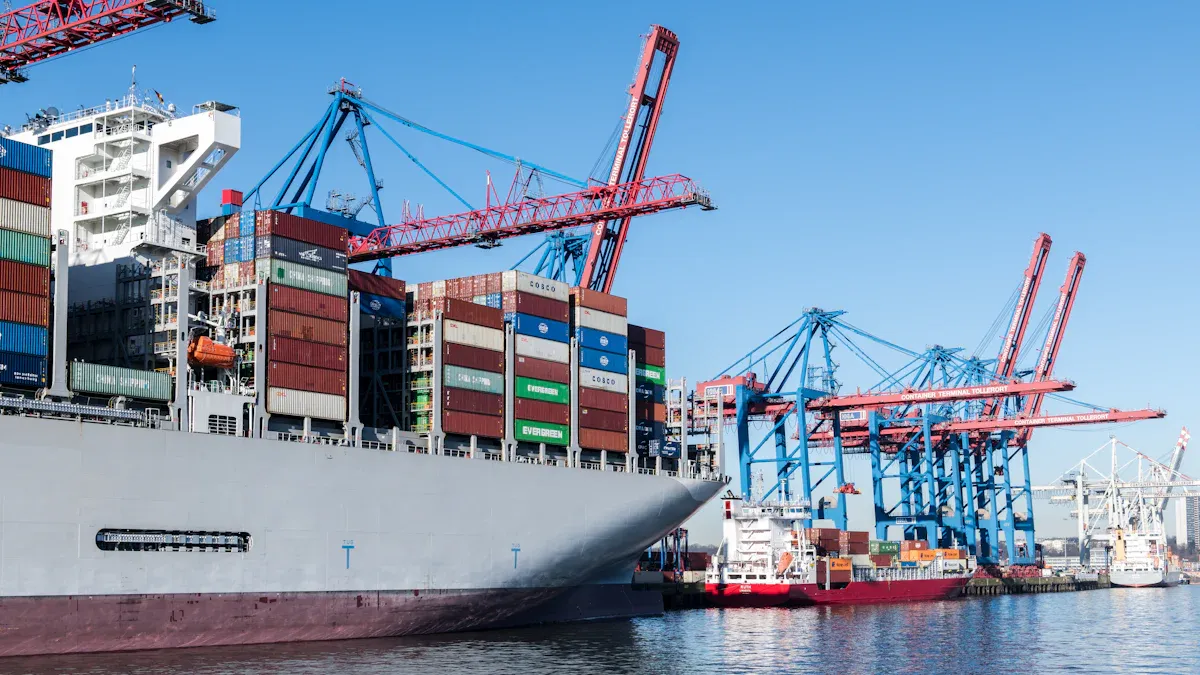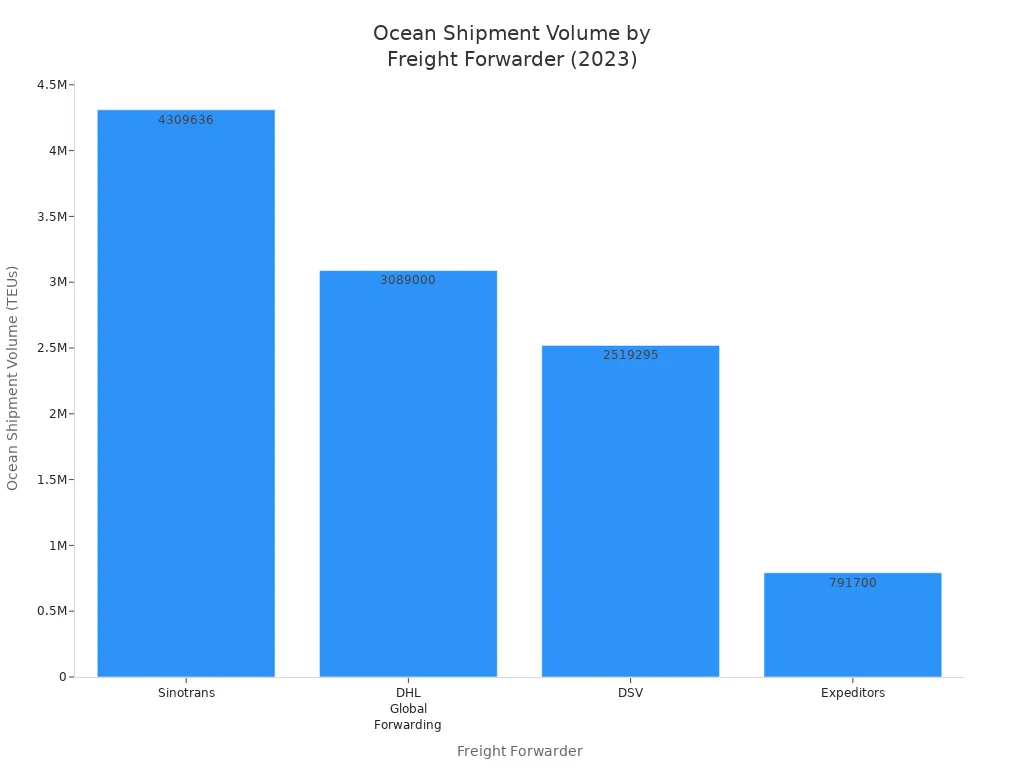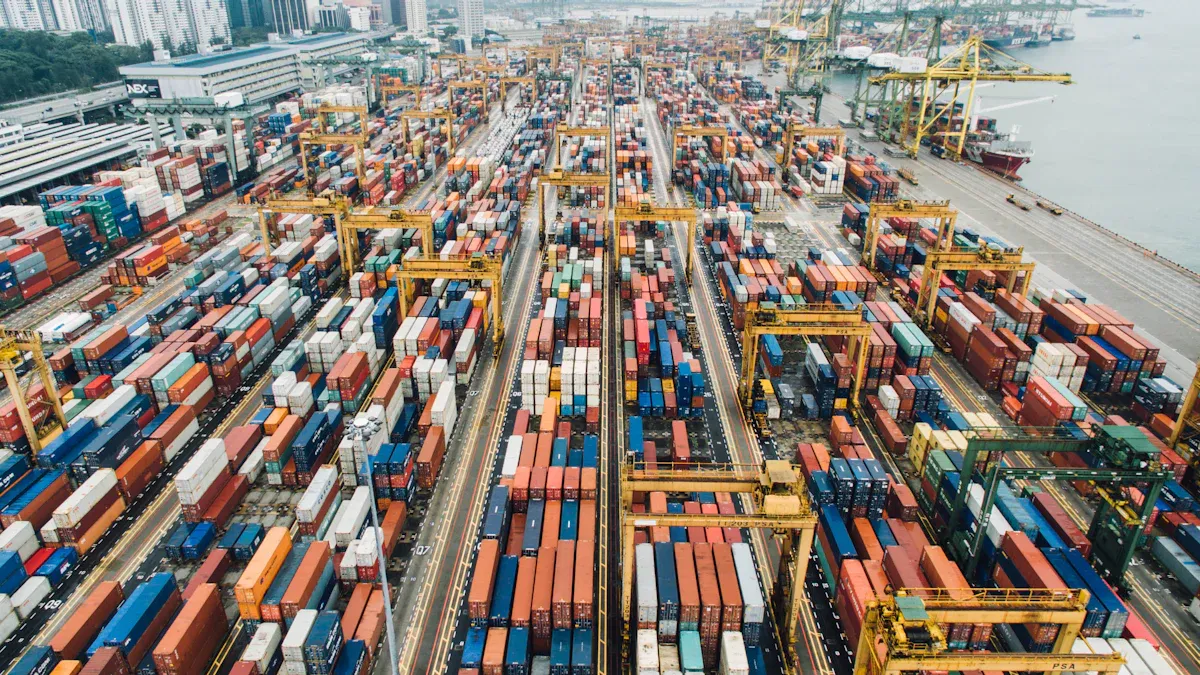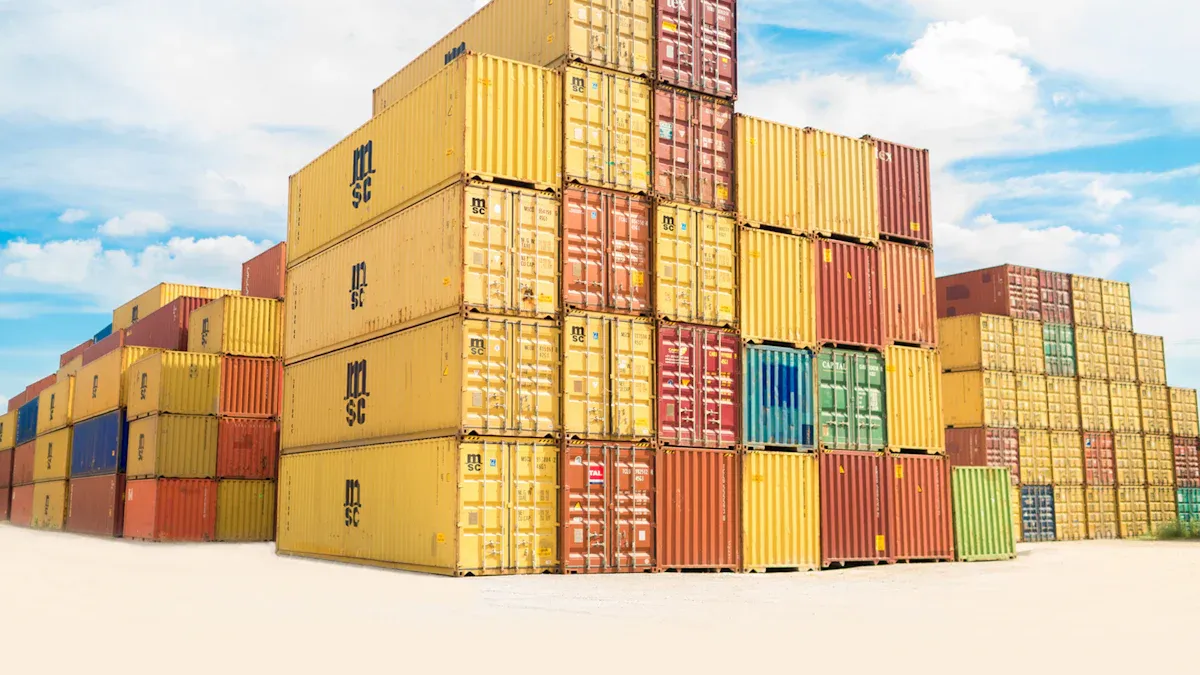How to Choose the Right International Freight Service

You want to feel confident when choosing international freight services. The best choice fits your shipping needs and the provider’s strengths. Reliability, cost, and speed are very important to global shippers, as shown below:
Priority Factor | Percentage of Global Shippers |
|---|---|
Speed of Delivery | 70.8% |
Cost of Delivery | 50.5% |
Reputation (Reliability) | 40.6% |
Industry data shows that freight rates can change fast if routes have problems. These changes can hurt supply chain efficiency for many companies. Picking the right provider helps you avoid delays and control costs.
Key Takeaways
Learn about your shipment. Know the type, size, and where it is going. Think about any special needs. This helps you choose the best freight service. - Look at how reliable the provider is. Check their reputation and where they deliver. This helps you avoid delays. It also helps your goods arrive safely and on time. - Compare prices and extra services. Use tools like real-time tracking. This helps you stay in control and makes shipping better.
Shipping Needs
You should know what you need before picking a freight service. This helps you find a provider that fits your needs. Ask yourself what you are shipping, how much you have, where it is going, and if it needs special care or paperwork.
Shipment Type
First, figure out what kind of goods you want to ship. International freight services move many things, like:
Cereal grains and farm products
Bulk items such as coal, crude oil, and gasoline
Chemicals, medicines, and fertilizers
Machinery, electronics, vehicles, and equipment
Mixed freight and finished products
You also need to know the shipment type. Some choices are Full Truckload (FTL), Less Than Truckload (LTL), intermodal, rail, air, and ocean freight. Each one is good for different speeds, costs, and cargo sizes.
Volume and Destination
How much you ship and where it goes matters a lot. Providers with big networks can handle more shipments and reach more places. The table below shows how top freight forwarders compare:
Freight Forwarder | Destination Coverage / Network Footprint | Specialized Services / Notes | |
|---|---|---|---|
DHL Global Forwarding | 3,089,000 TEUs (Ocean), 1,672,000 MT (Air) | Over 190 countries, network of 40,000 providers | End-to-end global service using a large network |
Sinotrans | 4,309,636 TEUs (Ocean), 902,000 MT (Air) | Big railway network in China, Southeast Asia, and Europe | Multi-modal transport with sea, air, and rail |
DSV | 2,519,295 TEUs (Ocean), 1,305,827 MT (Air) | Large global network | Sea-air service to save money and time |
Expeditors | 791,700 TEUs (Ocean), 782,000 MT (Air) | Global network | Sea+air services to lower costs and speed up shipping |

Special Requirements
Some shipments need extra care or special paperwork. You may need to follow export rules, fill out forms, or get special permissions. Providers help by:
Giving easy steps for export paperwork.
Getting permissions like Shipper’s Letter of Instruction.
Making sure all export rules are met.
Filling out and sending forms the right way.
Staying in touch to fix problems.
Watching for special rule needs.
Matching licenses and paperwork.
Sharing export records when you ask.
Tip: If you know your shipment’s details and special needs, you can pick a provider who keeps your shipment safe, on time, and follows the rules.
Service Coverage

Destinations
You want your goods to get to the right place on time. Freight providers do not all go to the same places. Some only work in certain areas. Others can ship almost anywhere in the world. The table below shows how top providers compare in country and location coverage:
Provider | Countries Covered | Locations Covered | Regional Focus / Notes |
|---|---|---|---|
DHL | 220+ countries | N/A | Broadest country coverage |
DSV | 80+ countries | N/A | Global coverage |
DB Schenker | N/A | 1850+ locations | Air & ocean: 550+, Land: 450+ |
Expeditors | 100+ countries | 350+ locations | Specializes in Canada and US |
C.H. Robinson | 150+ countries | N/A | Strong in North America, Europe, Latin America, Asia, Middle East, Africa, Oceania |
CEVA Logistics | 170+ countries | 1300+ locations | Strong in China, known for automotive logistics |
Nippon Express | 49 countries | 739+ locations | Focus on ASEAN, truck and cold chain logistics |
GEODIS | 65+ countries (direct) | N/A | Partners in 120 countries |
Hellmann Worldwide | 173+ countries | N/A | Extensive global coverage |
Kuehne + Nagel | 100+ countries | 1300+ locations | Regional bases in Europe, Middle East, Africa, Americas, Asia Pacific |
Tip: Make sure your provider ships to your country and city before you book.
Transport Modes
There are different ways to move your goods with International Freight Services. Each way is good for certain needs. The table below explains the main options:
Transport Mode | Key Advantages | Typical Use Cases | Potential Drawbacks |
|---|---|---|---|
Ocean | Low cost, high capacity | Bulky or heavy goods, long distances | Slow, weather delays |
Road | Flexible, door-to-door | Local, last-mile, small shipments | Traffic, theft risk |
Air | Fastest, secure | Urgent, high-value, remote areas | Expensive, limited space |
Rail | Cost-efficient, predictable | Bulk goods, long distances | Fixed routes, slower than air |
Pick the transport mode that fits your shipment best.
JUSDA China-Europe Express Rail
JUSDA’s China-Europe Express Rail is a smart way to ship between China and Europe. It takes 15-20 days from door to door. This is much faster than ocean shipping. It also costs less than air shipping. You can send electronics, clothes, and medical supplies safely. JUSDA has a strong network and knows customs rules well. This helps your goods cross borders without problems. If you want both speed and good prices, this rail service is a great choice.
International Freight Services Options

Air, Sea, Rail, and Land
There are many ways to ship your goods. Air freight is good for fast or expensive items. It is quick and keeps things safe. Sea freight is best for big or heavy loads. It costs less but takes longer. Rail freight is a middle choice for speed and price. It works well from China to Europe. Land transport uses trucks for local or nearby places. Each way is good for different needs. Pick the best way for your shipment.
Value-Added Services
Freight providers give extra services to help you ship better. These services make shipping safer and easier. They can help your supply chain and make customers happy. The table below lists some common services and their benefits:
Value-Added Service Type | Description | Impact on Satisfaction and Efficiency | Example |
|---|---|---|---|
Packaging and Re-Packaging | Custom packaging for safety and rules | Less damage, better delivery, brand visibility | Moisture-proof packaging cuts damage by 30% |
Labeling and Barcoding | Clear labels and tracking | Faster processing, fewer mistakes | |
Kitting and Assembly | Combine or assemble items | Saves time, reduces warehouse work | Home office kits cut workload by 40% |
Quality Control and Inspection | Check for defects and compliance | Fewer returns, more trust | |
Reverse Logistics (Returns) | Manage returns and recycling | Easier returns, more value recovered | 60% lost revenue recovered by reselling |
Vendor-Managed Inventory (VMI) | Auto stock checks and restocking | Prevents stockouts, better cash flow | Stockouts cut by 25% |
Customs Clearance and Compliance | Handle paperwork and rules | Fewer delays, easier global trade | Customs hold-ups cut by 50% |
Temperature-Controlled Logistics | Cold storage for sensitive goods | Product safety, longer shelf life | 99.9% vaccine delivery success |
Sustainability-Driven VAS | Eco-friendly packaging and reporting | Meets green goals, attracts customers | Plastic use cut by 80% |
Technology-Enabled VAS | Use of IoT, AI, blockchain for tracking | More visibility, less counterfeiting | Counterfeiting cut by 90% |
Note: These extra services help you get your goods delivered faster and safer.
JUSDA Solutions
JUSDA gives many choices for International Freight Services. You get:
All-in-one shipping, storage, and transport for speed and safety.
Tools that let you track your goods in real time.
Rail freight saves money and helps the environment. One switch from air to rail saved $10 million and cut emissions a lot.
Help with customs, insurance, and keeping track of your goods.
Tools that help you plan better and see where your goods are.
Warehouses in the Netherlands with special storage and rule checks.
New tech like AI and IoT for faster and smarter shipping.
You can count on JUSDA to keep your supply chain working well and clear.
Reliability and Reputation
You need to trust your international freight service. Reliability and reputation help you know if a company is good. These things show if your goods will arrive safe and on time. There are easy ways to check if a company is reliable.
On-Time Delivery
On-time delivery means your goods get there as planned. Good providers tell you their delivery records. You can ask for their on-time delivery rate. Many top companies have rates over 95%. If a provider will not show this, you might have delays.
Tip: Always ask for proof of on-time delivery. Good providers will give you this information.
Customer Reviews
Customer reviews are stories from other people who shipped goods. You can read these reviews on Trustpilot or Google Reviews. Look for comments about:
Delivery speed
Communication
Problem-solving
Care for goods
If most reviews are good, you can expect good service. If there are many bad reviews, you should look for another provider.
⭐⭐⭐⭐⭐ | "JUSDA kept me updated and delivered on time!" |
|---|---|
⭐⭐⭐⭐ | "Great service, but tracking could improve." |
Certifications
Certifications show a provider meets important industry standards. You should look for:
ISO 9001 (Quality Management)
ISO 14001 (Environmental Management)
AEO (Authorized Economic Operator)
These certificates mean the company follows strict rules. You can ask to see these certificates before you choose.
Note: JUSDA has important certifications and delivers on time. This helps you feel sure about your shipment.
Cost and Value
Pricing Structure
You want to know the cost before you ship. Most international freight providers have clear prices. They set prices by shipment size, weight, route, and speed. Some companies give discounts if you ship a lot or use them often. Big providers can get better deals with carriers. This helps you save money if you have a small business. Many top freight companies use technology to track shipments and control costs. These tools let you see your charges and avoid surprises.
Hidden Fees
Hidden fees can make your shipment cost more than you think. You should learn about these fees before you book. The table below shows common hidden fees and ways to handle them:
Hidden Fee Category | Examples / Specific Fees | How to Identify or Manage Them |
|---|---|---|
Detention & Handling Fees | Detention, layover, rework | Know free time limits, plan loading well |
Fuel Surcharges | Per mile or percent of base rate | Watch fuel trends, include in cost planning |
Peak Season Surcharges | Holiday or high-demand fees | Ship early, ask about peak rates |
Insurance Fees | Extra cargo insurance | Check coverage, request details |
Demurrage, Storage | Fees for late pickup or storage | Track free time, schedule pickups |
Customs & Equipment | Duties, taxes, crane or forklift fees | Research customs, confirm equipment needs |
Other Accessorial Charges | Oversized, residential, liftgate, HAZMAT | Choose commercial locations, bundle services |
Tip: Pick places with docks and load your goods yourself if you can. This helps you avoid extra charges.
Service Comparison
You should look at more than just price. Top freight providers like DHL, DB Schenker, and Kuehne + Nagel give extra features. These include real-time tracking, custom logistics, and green programs. Many use AI and blockchain to make service better and clearer. Big networks can combine shipments to lower costs. This helps you get better prices and good service. When you compare, check both the price and the extra services. This way, you get the most for your money.
Customer Support
Communication
Good communication helps make shipping easy and less stressful. You want a freight provider who answers fast and gives clear info. Many shippers like companies that use technology for better and quicker talks. Some top freight companies use special software to keep all your shipping details together. This lets them answer you faster and with better info.
Check if your provider can handle your shipment size and knows customs rules for your country. These skills help stop delays and make sure your goods arrive on time. Companies with automated systems and set steps give you the same good service every time. Fast replies and clear updates show your provider cares about your shipment and your business.
Tip: Pick a provider who cares about your experience and uses technology to keep you updated at every step.
Tracking Tools
Modern tracking tools give you more control over your shipments. You can see where your goods are any time you want. Many providers let you track in real time across different carriers and transport types. This means you get updates if your goods go by air, sea, rail, or road.
Real-time tracking lets you watch your shipment from start to finish.
Automated alerts tell you about any delays or changes.
Tracking pages and emails show delivery times and proof of delivery.
Some systems connect with your business software, so you do not enter data twice.
Analytics help you see how your shipments do and where you can save money.
These tools help you fix problems faster and keep your customers happy. When you know where your goods are, you can plan better and avoid surprises. Good tracking builds trust and makes shipping easier.
Compliance and Security
Customs Expertise
You need a freight provider who understands customs rules. Customs rules change from country to country. If you miss a rule, your shipment can get stuck at the border. Good providers know the paperwork you need. They help you fill out forms and get the right permits. Some providers use digital tools to track your shipment through customs. This helps you avoid delays and extra costs.
JUSDA has a strong customs team. They work with customs offices in many countries. Their experts help you follow all the rules. You get updates at every step. This support keeps your goods moving and reduces the risk of problems.
Tip: Always ask your provider about their customs experience. A provider with strong customs knowledge can save you time and money.
Insurance
Shipping goods across borders comes with risks. You want to protect your shipment from loss or damage. Cargo insurance gives you peace of mind. Not all providers offer the same insurance options. Some, like Ship4wd, give you instant quotes and fast claims. Others, such as Global Cargo Alliance, focus on low rates and help you through the claims process.
You should compare insurance plans. Look at what each policy covers. Some plans protect against almost every risk. Others have more limits. Check how fast the provider pays claims and what the coverage limit is. For example, some providers pay claims in days and offer high coverage, while others give more personal help during claims.
🛡️ Choose a provider who offers clear, strong insurance. This keeps your business safe if something goes wrong.
Comparing Providers
Research and Shortlist
You need to do research before picking a freight partner. Find a provider who fits your needs and can deliver safely and on time. Experts say you should follow these steps:
Write down what your business needs. Think about what you ship, how much, and where it goes.
Check if the provider has experience with your goods. Some companies know electronics or medical supplies better.
Look at their network. Make sure they can reach the places you need now and in the future.
See what services they offer. You might need air, sea, road, or warehousing.
Test how they talk to you. Good providers answer fast and give clear updates.
Ask about risk plans. See if they have cargo insurance and backup plans.
Ask for references. Other customers can tell you about their experience.
Make sure they have the right licenses and certifications. These show they follow industry rules.
You can use online lists, trade shows, and industry contacts to find good companies. Reading reviews and checking social media can help you spot problems. Always ask for references and check their history before you choose.
Tip: Making a good shortlist saves you time and helps you avoid mistakes.
JUSDA Advantages
When you compare providers, look for what makes each one special. JUSDA is different because of its global network, technology, and focus on certain industries. The table below shows how JUSDA compares to other big freight companies:
Aspect | JUSDA Supply Chain Global | Other Major Providers (e.g., DHL, DB Schenker, UPS) |
|---|---|---|
Global Network | 155+ locations in over 10 countries | Larger global networks |
Industry Focus | High-tech manufacturing, electronics, automotive, medical | Serve many industries |
Technology Platform | JusLink platform with AI and IoT for real-time insights | Advanced tech, but less focus on AI/IoT for complex logistics |
Partnerships | Close ties with Foxconn Technology Group | Independent or other partnerships |
Team Culture | Collaborative, diverse, and inclusive | Varies, often large corporate cultures |
Technological Edge | Modern tech stack, Microsoft Azure, AI, IoT | Advanced tech, but JUSDA highlights integration and agility |
JUSDA’s JusLink platform lets you track your shipments in real time. This helps you see where your goods are at every step. JUSDA is also good at handling complex supply chains, especially for electronics and manufacturing. If you want a partner who uses new technology and knows your industry, JUSDA is a strong choice.
Note: JUSDA’s focus on new ideas and teamwork means you get solutions made for your business, not just basic shipping.
Request Quotes
After you make a shortlist, you need to compare prices and services. To get the right quotes, give each provider the same details:
Where your shipment starts
Where your shipment goes
How much your shipment weighs
The size (length, width, height)
The transport mode (air, ocean, trucking, rail)
Any extra services you need, like customs help or insurance
When you give this info, you get quotes that include all costs and services. This makes it easy to compare providers side by side. Look for clear cost breakdowns and ask questions if you do not understand something.
📝 Always ask for a written quote. This protects you from hidden fees and helps you compare fairly.
If you follow these steps, you can pick the best partner for your International Freight Services. Take your time, ask questions, and choose a provider who fits your needs and values.
Final Decision
Evaluate Proposals
You need to look at each proposal carefully before you choose a freight provider. Focus on more than just price. Use these key criteria to guide your review:
Make sure your shipping goals match the provider’s strengths.
Check if the provider understands market trends and can handle changes.
Keep a mix of partners, including those with special skills.
Confirm the provider has the right people and technology.
Communicate clearly with your team and the provider.
Look at service quality, not just cost.
Tip: A provider who meets your KPIs and fits your strategy will help your business grow.
Negotiate Terms
You can get better terms by preparing well and using smart strategies. Start by knowing your shipping needs and checking your current contracts. Compare offers from different providers. Bring in experts if you need help. Use these steps:
Gather information and set your goals.
State your needs and limits clearly.
Talk about interests, not just price.
Use facts to support your requests.
Write down all agreements and make a plan for follow-up.
Build trust by keeping communication open.
Stay flexible where possible.
Make sure both sides are committed to the deal.
Remember: Good negotiation can lower your costs and improve service.
Agreements
A strong agreement protects your interests. Make sure your contract includes these elements:
Description & Importance for International Freight Agreements | |
|---|---|
Offer | Lists duties and what each side must do. |
Acceptance | Shows both sides agree clearly. |
Awareness | Confirms both sides understand and want the deal. |
Consideration | States what each side gives or gets. |
Capacity | Checks that both sides can legally sign. |
Legality | Makes sure the contract follows the law. |
Add clear rules for what happens if someone breaks the contract. Review all terms with care. This keeps your shipments safe and your business protected.

JUSDA Solutions
To provide you with professional solutions and quotations.
Picking International Freight Services is easier if you have a plan.
Having steps to follow helps you look at important things like reliability, cost, and speed.
You can find a provider that fits your needs and get better results.
A company that makes networking hardware used JUSDA’s China-Europe Express Rail. They saved money and lowered pollution. They could also see their shipments in real time. You can get these same benefits if you choose JUSDA for your shipping needs.
See Also
Comprehensive Insights Into Leading Worldwide Logistics Firms
Discover The Latest Trends In Sea Freight Logistics 2024
Top Reasons To Join The Best Logistics Webinars Today
In-Depth Look At The Future Of LTL Freight Shipping
JUSDA’s Expert Strategies For Effective Inventory Optimization
